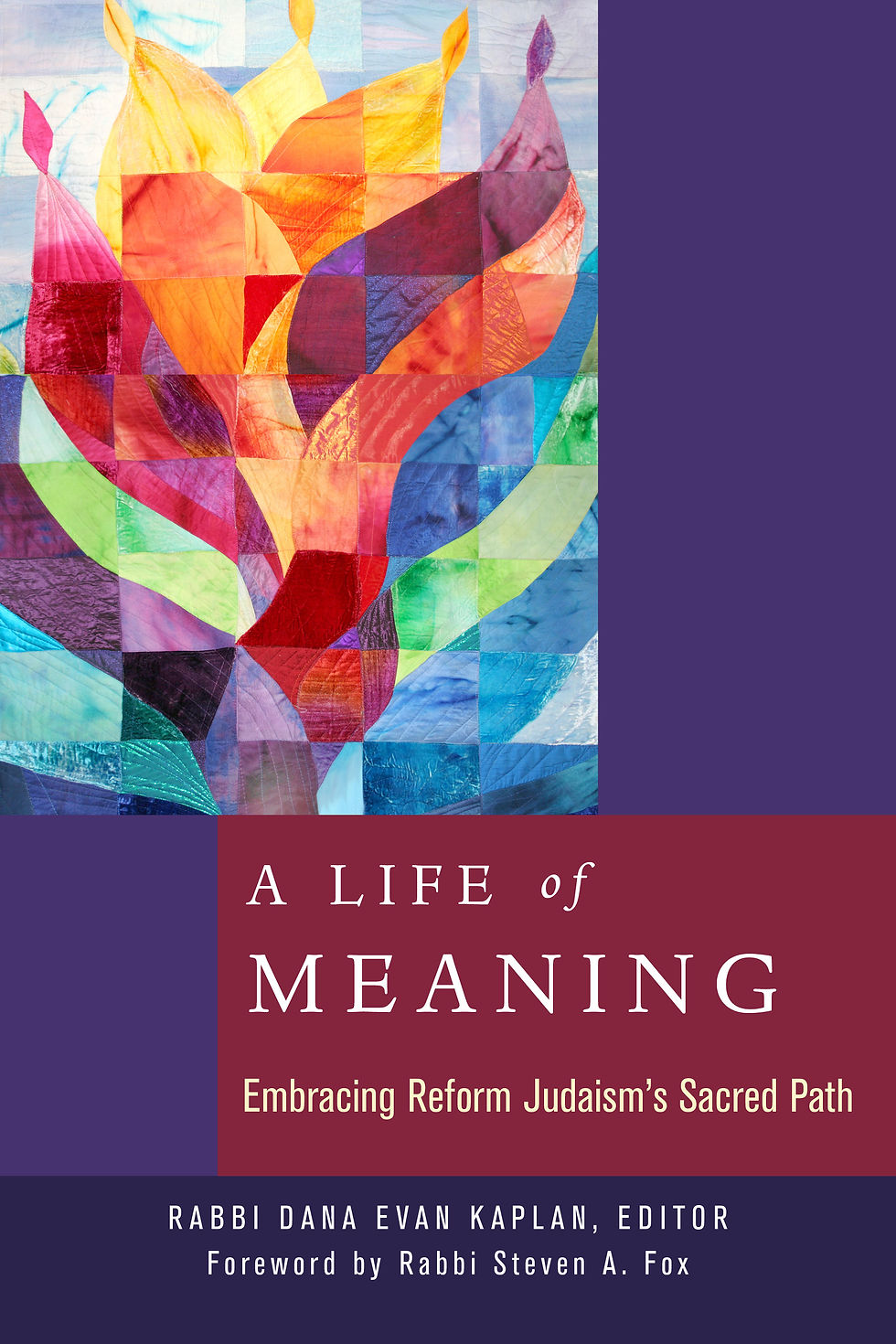My Newest Book has just been published! A Life of Meaning: Embracing Reform Judaism's Sacred Pat
- Dana Evan Kaplan
- Nov 30, 2017
- 4 min read

My newest book has just been published! It is a 630 page collection called A Life of Meaning produced by the CCAR Press, the publishing arm of the Reform movement of Judaism. If I am counting right, there are 59 contributors. I feel proud to have been able to publish this manuscript while serving as the religious leader of a congregation right here in Mobile, Alabama.
I wrote about this for the CCAR Blog http://ravblog.ccarnet.org/2017/11/embracing-reform-judaism-behind-scenes-life-meaning/
My dream of editing a book on Reform Judaism for the CCAR Press began germinating in college.
Late one evening, I wandered into the Judaica section of the library and came across a volume called Reform Judaism: A Historical Perspective, edited by Joseph L. Blau. (I still remember that books dealing with Reform Judaism were numbered 296 by the Dewey Decimal System.) This volume presented a collection of essays originally published in the yearbook of the Central Conference of American Rabbis, and archived eighty years’ worth of material most indicative of Reform concerns over that time span. I thought it might be neat to edit something similar but more modern. And now here it is.
Compiling material for A Life of Meaning was a very different task than the one that Blau undertook. We knew that we wanted something broader than a collection that focused on specific issues within our Movement, and we knew that we wanted the volume to address the more existential questions concerning our community at large.
Ultimately, we wanted A Life of Meaning to present original works on a spectrum of important topics—something that would both reflect who we are and what we believe today. Perhaps even more importantly, however, we needed to make sure that A Life of Meaning would provide Reform Jews a door into the discussion of what our religion means in today’s world.
I knew that this could not be a single-authored volume; what we envisioned required multiple perspectives on what Judaism means and how this meaning is expressed. Such a volume calls for viewpoints diverse enough to speak to the varying beliefs, practices, and experiences of as many individuals and organizations of the Reform Movement as possible.
The challenge was to create a manuscript that simultaneously embodied this diversity while carving a clear path into the heart of what it means to be a Reform Jew, not just for those looking in from the outside, but for every Reform Jew who, at heart, feels any uncertainty about what it means to identify as Reform. We wanted a text that would help them enter into Reform Jewish thought not as an academic discipline, but as a set of core concepts that contribute to making a life of meaning, both for the individual and, perhaps even more importantly, for the members of the Reform community.
Little by little, we began collecting tentative essay topics and titles, then longer descriptions of what each essay might look like and, finally, the essays themselves. The number of authors with whom I was in touch started to expand exponentially, and the diversity within the Reform Movement became even more strikingly clear. I was amazed at the distinct attitudes, approaches, and beliefs of each author in this collection, and was even more amazed by their dramatically varied lifestyles. Despite their differences, however, the congregations and communities to which they belonged or which they led always had much in common.
Putting together a volume of this sort is, as the saying goes, a little bit inspiration and a lot of perspiration—the completed volume is very much a testimony to the many thoughtful and talented people constituting the American Reform Movement today. Contemporary American life just does not fit into the theoretical categories that religious-studies scholars and others have theorized about and expected to find. But our goal is not to prove theoreticians right or wrong; it is to create texts that can serve both as source material for greater knowledge and as sources of spiritual inspiration. We wanted to create a volume to be read, not just by individuals, but by study groups and entire communities. We wanted to create a text that would stand as a living source of discussion and dialogue, promoting Reform Judaism among, first and foremost, those most likely to embrace it.
While it is enormously gratifying to put the project to rest and to see the finished product, it is hard to accept that the many correspondences and discussions involved in creating this book have come to an end. Our hope, of course, is that the published book—whether in print or eBook—will take on a life of its own as a wellspring of discourse that will not only continue to inform, but to transform, our understanding of what it means to embrace Reform Judaism in the worlds of today and tomorrow.
The book is available from
https://www.ccarpress.org/shopping_product_detail.asp?pid=50397
https://www.amazon.com/Life-Meaning-Embracing-Reform-Judaisms/dp/0881233137/ref=sr_1_fkmr0_1?ie=UTF8&qid=1511825786&sr=8-1-fkmr0&keywords=a+life+of+meaning+embracing+reform+judaism+s+sacred+path
Rabbi Dana Evan Kaplan, PhD, is one of this generation’s foremost chroniclers of Reform Judaism. His works include The New Reform Judaism; Contemporary American Judaism: Transformation and Renewal; The Cambridge Companion to American Judaism; American Reform Judaism: An Introduction; Platforms and Prayer Books; and Contemporary Debates in American Reform Judaism. He currently serves as the rabbi of the Springhill Avenue Temple in Mobile, Alabama.




Comments